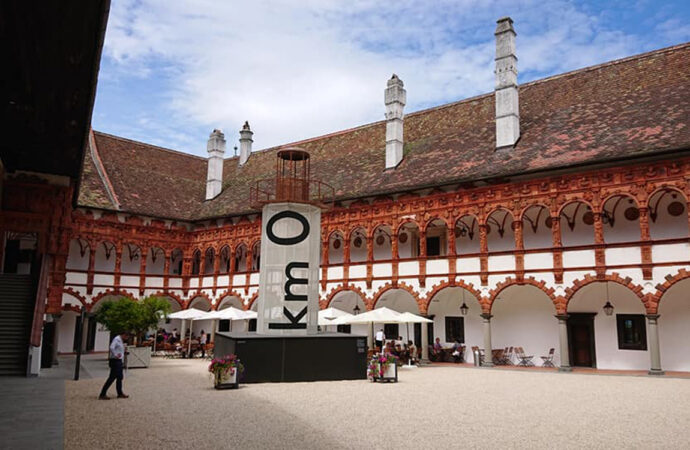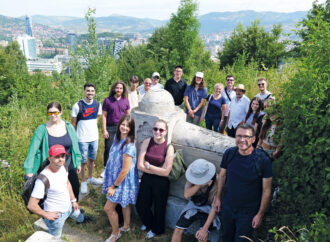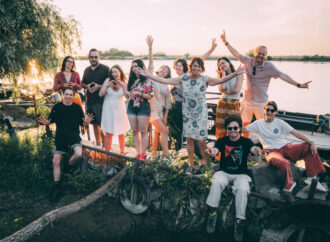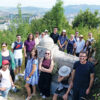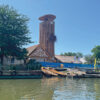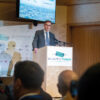Is it possible to plan a “shorttrip” along the whole Danube? Thanks to a current exhibition in Schallaburg in Lower Austria, it is! Danube Connects has set out on a journey from the Danube’s mouth to Schallaburg and on to Donaueschingen to discover the secrets of the second longest river in Europe. “2840 kilometres to
Is it possible to plan a “shorttrip” along the whole Danube? Thanks to a current exhibition in Schallaburg in Lower Austria, it is! Danube Connects has set out on a journey from the Danube’s mouth to Schallaburg and on to Donaueschingen to discover the secrets of the second longest river in Europe.
“2840 kilometres to the sea”, says a sign in the castle park. We are in the town of Donaueschingen in the Black Forest, at the official source of the river that shaped our European history like no other. There are many myths and secrets about the Danube, which flows into the Black Sea. You could, of course, journey “from Black to Black”.
But that would take at least two weeks. From the west, the Danube meanders, sometimes calmly, sometimes thunderously, towards the east and crosses more different countries, cultures and traditions than any other flowing water in the world. Its history is turbulent, mysterious and mythical, it was a waterway, natural border and economic area at the same time. People, treasures & cultures. The exhibition “Danube – People, Tresasures & Cultures” explores these secrets, but also historical backgrounds. Here, visitors embark on a journey of about 2000 kilometres upstream from the Sulina lighthouse on the Black Sea to the exhibition site Schallaburg, the most beautiful Renaissance castle north of the Alps. The castle is not located on the Danube. The European lifeline is about five kilometres away as the crow flies. Nevertheless, the prestige object, owned by the state of Austria, hosts international exhibitions, and cooperates with the largest museums in Europe. As in the case of the Danube. The visitor “travels” through its history in ten chapters, including culture and myths – an emotional road trip on foot through wonderful landscapes and cities. The exhibition includes something from each and every Danube country. There is much to discover and experience. Is the Danube a border or a bridge? How did it contribute to Central European culture? We learn about the fate of the Ottoman village of Ada, which no longer exists today, as well as about the eight-meter-long Huso sturgeons. In the exhibition we can see a three-meter-long specimen that was caught around 1910. Today there are still some small ones in the delta. Further to the west, they fell victim to overfi shing and hydroelectric power stations. And then there is the Neolithic Vinča culture from Serbia, which developed about 7000 years ago. Unique exhibits from the Serbian National Museum can be seen, such as a baby spoon made of bones, on which there are imprints of children’s teeth and traces of milk. The 2000 km long short trip takes about two hours. We take a break in the restaurant, which is located in the impres- sive arcade courtyard, decorated with elaborate terracotta elements. This masterpiece was created in the 16th century at the behest of the von Losenstein family. They were among the most influential Protestants from 1560 to 1600. Christoph von Losenstein sent his son Wilhelm to Italy around 1560. He retur- ned with creative impressions. And so, the idea for the unique inner courtyard of the castle was born. About 1600 parts were used! Quite a lot, considering the eff ort involved. To obtain a perfect work of art, an average of three fi ring attempts per specimen had to be made. It is assumed that 7000 to 8000 copies were burned. Visitors can admire representations of Greek mythology, Roman emperors, but also the septem artes li- berales. Especially the latter, the “seven liberal arts” are of great importance, sin- ce Martin Luther based his whole edu- cational system on them. Building the courtyard took about ten years. Now the lord of the castle had a fantastic inner courtyard, but the project had ruined him fi nancially. In the 17th century, Catholics were on the rise again, with the counter-reformation of the Habsburgs. After the Reformation in the 16th century, Austria is 80 percent Protestant. Most aristocrats adopt Luther’s theses in order to free themselves from the clutches of the church. Unlike the Habsburgs, who have their power in monasteries, for Lower Austria had been in Bavarian hands since about 800 AD, when the fi rst settlers came from there. We visit the oldest part of the castle, which was built around 1000 AD. A ruin without a roof and yet it seems to be a place of power. Plants grow from the walls. Mason bees inhabit the hol- low places behind it. Apart from the buzzing and the birdsong, nothing can be heard. But why is the roof missing? The so-called roof tax is responsible. It was introduced by the Holy Roman Emperor Joseph II. In order to save un- necessary taxes, the roof was dispensed with here, as this part of the castle was no longer in use. What is used again, however, is the magnifcent Renaissance garden, which was restored in the seventies. It was built according to old records and is one of the few preserved gardens from that time. We sit in the shade of the apple trees – three European women from Vienna, Ulm and Sarajevo. What is the Danube now? Border or bridge? The Danube has brought us together on wondrous paths. And it will continue to do so – despite all borders!
Mirella Sidro,
journalist, Augsburg


